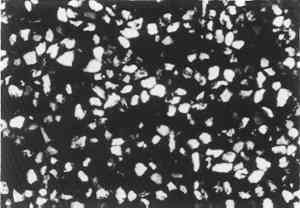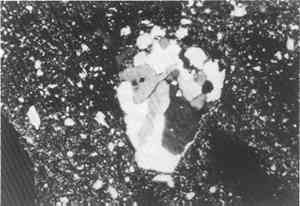THIN-SECTION PETROGRAPHY IN STUDIES OF CULTURAL MATERIALSCHANDRA L. REEDY
4 MISCELLANEOUS MATERIALS4.1 CLAY CORE MATERIALS FROM BRONZESHollow-cast metal sculptures frequently have an inner clay core material. This clay is often only sun-dried rather than baked or fired, so it is not strictly classified as a ceramic material. The strength of a fired ceramic is not required for this application. Furthermore, fine clays are not necessary since plasticity is not important. A major sand component is advantageous since it helps to prevent gas bubbles during casting by
Because of the sandy nature of most clay core materials, some of the most useful petrographic work has come from in-depth studies of variation in the quartz grains. Since quartz is by far the most abundant mineral in sediments, it has received much attention in geology as a source indicator, and many features such as texture, size, shape, and inclusions have been identified as important for provenance work (Scholle 1979; Folk 1980)(figs. 9 and 10). For example, lattice dislocation in quartz can produce grains made up of a number of subcrystals with different crystallographic orientations, called polycrystalline quartz. Such lattice dislocation may be more common in metamorphic rocks, so this quartz feature may indicate sediments with metamorphic source rocks, especially if the boundaries between subcrystals are sutured rather than straight (Adams et al. 1984; Basu 1985). In addition to quartz studies, noting the presence or absence of numerous accessory minerals is an important part of thin-section studies of clay core materials.
4.2 PLASTERS AND CEMENTSPlaster may contain burnt lime, gypsum, clay, sand, water, and organic materials. It is used as a coating for architectural surfaces such as walls and floors and may also be used to produce objects such as beads, figurines, or vessels. Thin-section petrography is used to identify the various components of a plaster and their respective proportions. It can also give information such as grain size, mineral impurities present in the sand or lime, textural characteristics of minerals, and degree to which Goren and Goldberg (1991) found that since thin sections provide information on grain textures and interrelationships, they were more useful than other techniques (such as x-ray diffraction, scanning electron microscopy, and elemental analysis) for reconstructing Neolithic lime plaster production technology in northern Israel. Thin-section analysis was also the primary method of a major study that characterized the calcareous cements used in pre-Hispanic Mesoamerican building construction (Hyman 1970). Besides just identifying the major components, Hyman was able to discern the types of microfossils present in the lime and the grain size and degree of rounding. With this information he could deduce the environment in which the limestone must have formed and thus narrowed the possible locales where it could have been collected. Klemm and Klemm (1991) used thin sections to characterize mortar samples from the pyramid districts of the Old Kingdom in Egypt. Contrary to earlier assertions, they determined that both gypsum and lime mortars were used. Although plaster of paris is a very fine-grained, highly processed material, it, too, is amenable to thin-section studies. Variation in this gypsum-based material is found in features such as particle size; the presence of mineral contaminants or additions such as quartz, carbonates, and clay; and the percentage of various anhydrite and gypsum phases (natural or high-temperature anhydrite; dihydrate, alpha hemihydrate, or beta hemihydrate phases of gypsum) (Kuntze 1984). Since gypsum dissolves relatively easily in water, thin-section preparation of gypsum-containing materials must use an oil-based preparation method. 4.3 FRESCOESPetrographic analysis has potential usefulness in the study of conservation treatments for frescoes. One common problem is the consolidation of surfaces that are crumbling and friable due to excess humidity. Vagts (1993) included thin-section analysis as part of her research into the potential of colloidal silica in a sol-gel form (Ludox-SM colloidal silica dispersed in water) for consolidation of friable surfaces of frescoes. Thin sections of consolidated and unconsolidated samples were compared to examine the effect of the consolidation as well as the depth of penetration. The unconsolidated sample had a much more fractured appearance than the consolidated one. In addition, it was possible to see that the silica dispersion had penetrated approximately 3 mm into the surface, although the penetration was very uneven across the surface. One advantage of a standard thin section is that the mineralogy and microtexture of the fresco can easily be characterized as part of the study—important considerations for any study of deterioration and treatment of a material. Another is that the structure and grain relationships can be monitored before and after treatment and any other potentially adverse changes noted. With the relatively large area of a standard thin section, one can also easily observe the degree of consistency in depth of penetration of the consolidant. 4.4 SLAGSSlags are waste products from the reduction of metals from ores. They are frequently present in archaeological collections and at historic sites. Most common in such collections are slags from copper smelting and iron smelting and smithing. Tin and lead slags are also sometimes encountered. The value of slag is not always recognized by curators, and sometimes irreplaceable collections have been destroyed to make space for objects more readily recognizable as cultural artifacts (MacMahon A wide variety of minerals might be visible in slag thin sections, including many silicates, oxides, and sulfides. These minerals provide information about the composition of ores and fluxes that were used. The amount of metallic inclusions in slag indicates the efficiency of smelting operations, since the goal was to remove as much of the metal as possible. Furthermore, because the temperature of formation of minerals is well understood, the identification of mineralogical content helps in the reconstruction of temperature ranges achieved during smelting. |


